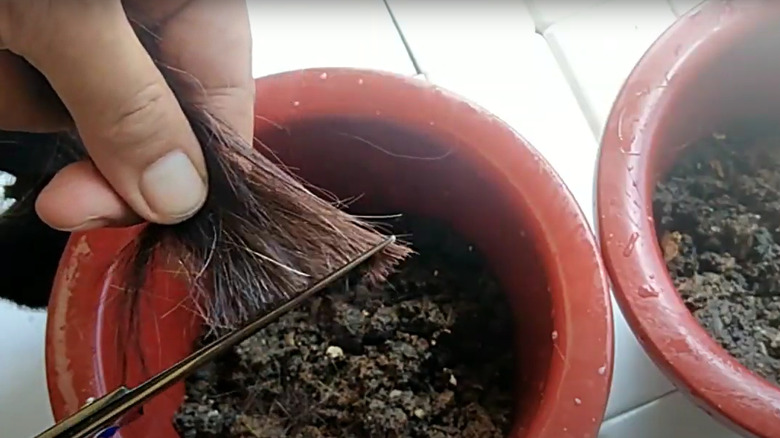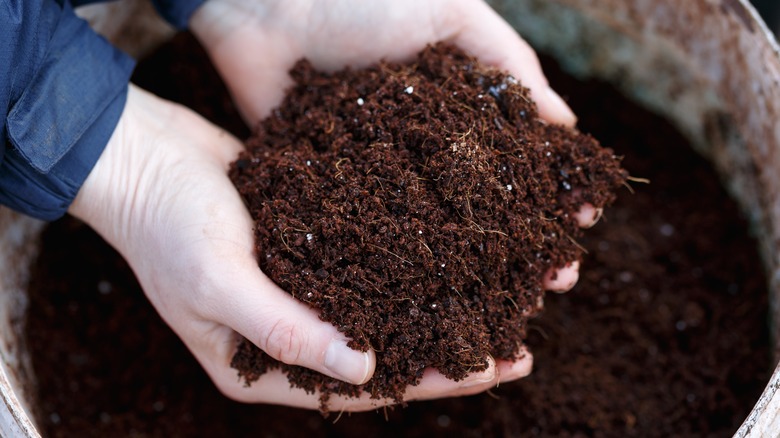Why Human Hair Can Actually Be Used As An Effective Soil Fertilizer
Take a moment to appreciate the humble hair; these little strands are much more powerful for plants than we realize, so don't let them go to waste! Next time you're cleaning out the shower drain or clearing clumps from your hairbrush, save some hairs for your garden. Adding hair to your planting medium or compost pile can give garden plants a major boost of nutrients, help the soil stay bouncy and hydrated, and bring some impressive produce back to your table. Because it contains high levels of nitrogen and other micronutrients, hair can essentially be used as natural fertilizer!
On average, a single person will lose up to 100 hairs every day, according to Healthline. Most of these hairs go unnoticed, blowing away in the breeze, washing down our drains, or collecting on our hairbrushes, but by saving your hair to use in the garden, you can reap a surprising handful of benefits. Hair has more versatile uses than commercial fertilizer alone. Here's why you should consider enriching your soil with hair, what kinds of hair you can use, and other purposes for hair that you might not have known off the top of your head.
Breaking down the benefits of hair
The whole family can contribute hair to the garden — even your furry pals. Head hair, leg hair, cat hair, dog hair, goat hair, and more can all be given a second purpose among your plants. It doesn't matter much what kind of hair you use; all hair is good for plants and can help enrich the soil because it contains high levels of magnesium and other micronutrients. Plants need magnesium to build chlorophyll molecules, which produce energy and give their leaves a healthy green color. Besides magnesium, hair is also comprised of carbon, nitrogen, oxygen, hydrogen, and sulfur. Nitrogen is one of the most common key ingredients in commercial fertilizers, so it makes sense that hair could help your plants thrive. Other micronutrients in hair, including keratin, can even help your fruits and vegetables grow bigger and juicier too!
In addition to its many nutrient benefits, hair also has physical properties that keep soil bouncy, aerated, and healthy. The individual hair fibers create strong places, like a net, giving roots something to cling onto and making it difficult for weeds to push through. Hair also helps to bind the soil together without packing it, improving drainage and resisting erosion.
Utilizing hair in your garden
Start by collecting a small bag of hair from around your home. When the bag is full, separate the clumps of hair and mix them evenly into your compost pile or directly into the soil before planting seeds or sprouts. Human hair can take a long time to break down naturally, up to two years, to be exact, so you may want to cut up your clumps into more manageable pieces before mixing. Water the soil to help everything settle, then sit back and observe the awesome fertilizing benefits! Add more hair pieces to your garden about once per year, before the peak growing season, to aid your plants in producing more fruits and vegetables.
Aside from being used as fertilizer, hair can also be used to help your garden in other surprising ways. Hang leftover hair in a cloth netted bag for birds to use as insulation in their nests. While birds aren't afraid of a bit of hair, deer and rodents can be. Hanging fresh bundles of human hair or sprinkling strands around your garden will introduce your scent to the space. When deer and rodents smell a potential predator, they'll know to stay far away!

